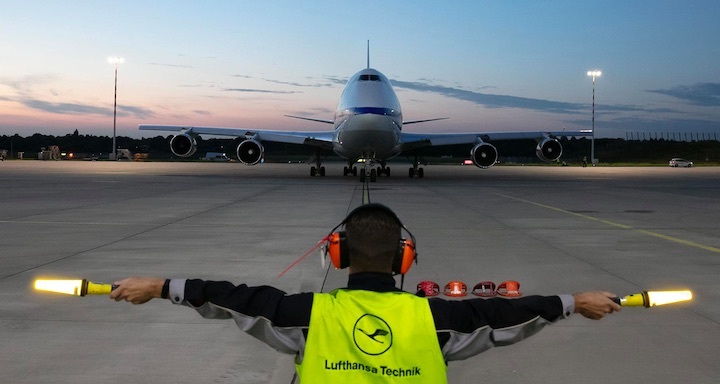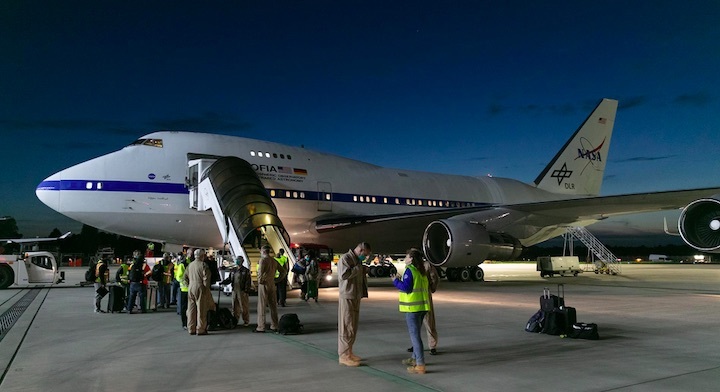5.10.2020

The Stratospheric Observatory for Infrared Astronomy (SOFIA) is making another 'pit stop'. At 19:17 on 30 September 2020, the airborne observatory, which is operated by the US space agency NASA and the German Aerospace Center (Deutsches Zentrum für Luft- und Raumfahrt; DLR), landed at Hamburg Airport. There, it will undergo a routine 'C check' at Lufthansa Technik. During this check, which takes place approximately every three years, the Boeing 747SP will be put through its paces. "We are looking forward to the renewed cooperation with Lufthansa Technik," explains Heinz Hammes, SOFIA Project Manager at the DLR Space Administration. "The special circumstances this year require cooperation and flexibility from all parties involved. We are convinced that we are in the right place for the tasks ahead."
New climate control for the research instruments
During this year's C check, the engine nacelles and cabin, including the panelling and floors, will be dismantled. This is necessary in order to be able to carry out the test and maintenance work and to check all cabling and fuel lines. The air conditioning system will also be upgraded. "This will enable us to adjust the temperature in the cabin very accurately in future," explains Hammes. "This is particularly important in the instrument zone, because every research instrument requires a precise ambient temperature." The final checks at Lufthansa Technik – for example on the engines and cabin pressurisation – are scheduled for mid-December. The maintenance work should be completed by the beginning of February and SOFIA will then be available for new scientific flights.
Maintenance work on telescope and research instrument
The telescope – the German contribution and the heart of the observatory – will also be thoroughly serviced during the stay in Hamburg. This work will be carried out by the German SOFIA Institute (Deutsches SOFIA Institut; DSI), which is based at the University of Stuttgart. This involves more complex work, which is only due every three to six years. However, a large number of smaller, routine measures are also on the to-do list, such as the inspection of the 2.7-metre primary mirror and software updates for the electronic control systems.
This year, one of SOFIA's six scientific instruments has also come to Hamburg. The German REceiver for Astronomy at Terahertz Frequencies (GREAT) will be detached from the telescope and transferred to the Max Planck Institute for Radio Astronomy (MPIfRA) in Bonn for maintenance and optimisation.
Special safety precautions during the Coronavirus pandemic
All work on the aircraft will be carried out under strict safety measures due to the Coronavirus pandemic. Both Lufthansa Technik and NASA have developed and coordinated comprehensive procedures for working in and on the aircraft. These include the requirement that no more than 15 people may be on board at any one time. This means that only absolutely necessary personnel have access. Due to the long-standing cooperation of all those involved, the work on the aircraft itself is largely routine. "In 2014 and 2017, we experienced an exceptionally good cooperation with our colleagues from DSI, DLR and NASA and we are pleased to be able to continue this now," says Sven Hatje, the Project Manager at Lufthansa Technik responsible for the C check on SOFIA, "It is nice to be able to welcome SOFIA again."

SOFIA
SOFIA is a globally unique airborne observatory that investigates space in the infrared spectrum. For example, the observatory investigates how Milky Way systems develop and how stars and planetary systems are formed from interstellar molecular and dust clouds. This is made possible by a 17-tonne telescope with a mirror diameter of 2.7 metres, developed and manufactured in Germany. SOFIA has six different scientific instruments, two of which come from Germany.
The Stratospheric Observatory For Infrared Astronomy (SOFIA), is a joint project of the German Aerospace Center (Deutsches Zentrum für Luft- und Raumfahrt; DLR) and the National Aeronautics and Space Administration (NASA). The German contribution to the project is managed by the DLR Space Administration, using funds provided by the Federal Ministry for Economic Affairs and Energy (Bundesministerium für Wirtschaft und Energie, BMWi), the State of Baden-Württemberg and the University of Stuttgart. German scientific operations are coordinated by the German SOFIA Institute (Deutsche SOFIA Institut; DSI) at the University of Stuttgart; US activities are coordinated by the Universities Space Research Association (USRA). Development of the German instruments is funded by the Max Planck Society (Max-Planck-Gesellschaft; MPG), the German Research Foundation (Deutsche Forschungsgemeinschaft DFG) and DLR.
Quelle: DLR
